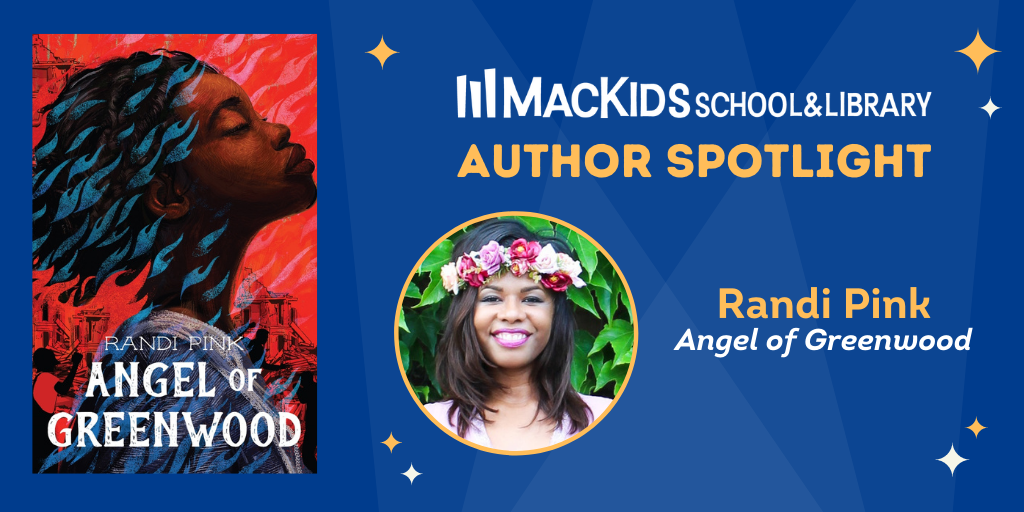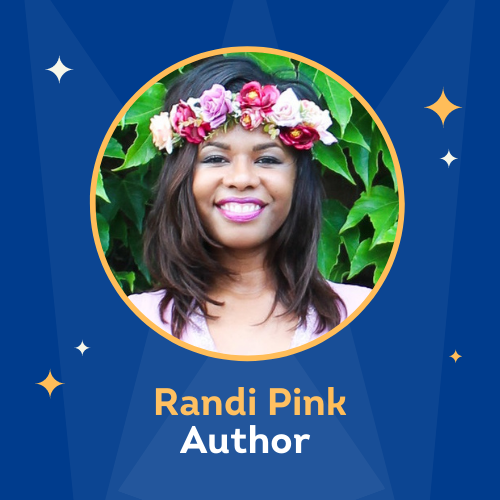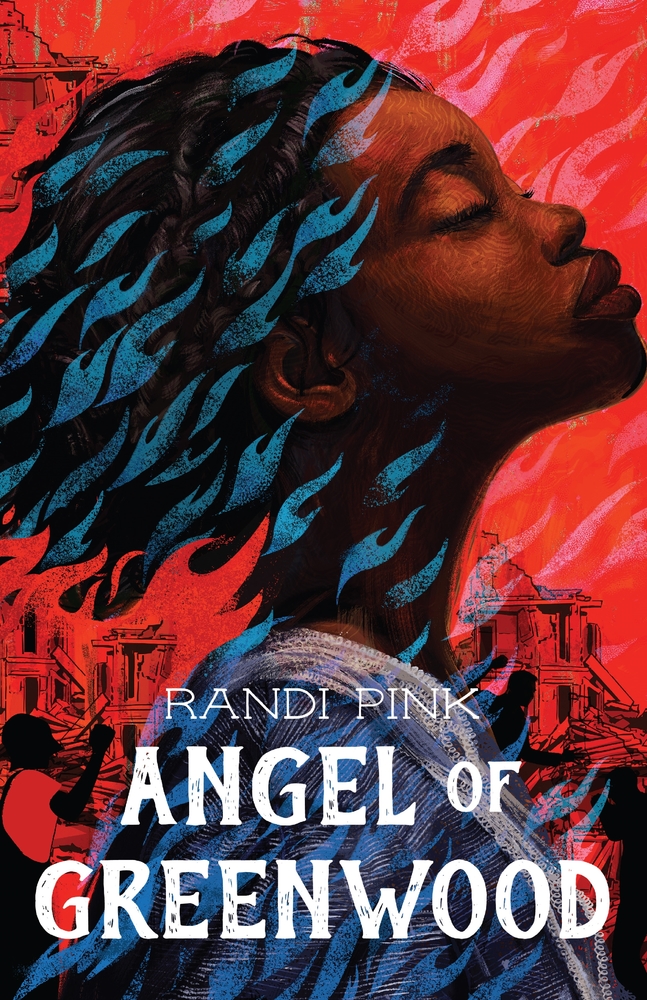
This month we’re interviewing Randi Pink, author of Angel of Greenwood. May 31, 2021 marks 100 years since the Tulsa Race Massacre. In this historical fiction account of the tragedy, the thriving Black community of Greenwood in Tulsa, OK is destroyed by an angry mob of white people. Randi Pink honors the real victims of Greenwood by acknowledging the strength and resilience in this community and two teenagers who fall in love in the midst of chaos.
Randi shares more about her inspiration for the story and what she hopes young readers will learn here.

When describing Angel of Greenwood, what’s your elevator pitch?
Randi Pink: Angel of Greenwood is the YA historical fiction tale of Angel and Isaiah walking the streets of Tulsa’s Greenwood District also known as Black Wall Street. It’s the story of two brilliant Black teens debating ideas of how their people move forward on the heels of Reconstruction. Sharing books and falling in love in a place designed and built by Black hands on the eve of 1921’s Tulsa Race Massacre.
What inspired you to write Angel of Greenwood?
Randi: Being caught in the wicked web of segregation inspired this book.
When my daughter was born, I began to notice how deeply divided my city actually was, so I dreamt up a place for us to live. I called this fictional place my Wakanda. There was no vibranium in my Wakanda. It was just a beautiful Black town where my beautiful Black children could safely move through it. When I shared my Wakanda dream with a wonderful librarian, she told me it sounded a lot like Greenwood. After that conversation, I immediately began researching for and writing Angel of Greenwood.
May 31, 2021 marks 100 years since the Tulsa Race Massacre. What do you hope readers will learn from your account of this tragic event?
Randi: I just want people to know about it. Not only the Massacre, but Greenwood itself. The miracle of Greenwood, created by Black people – some formerly enslaved and/or directly descended from enslaved people. The fact that Greenwood rose in the first place is such a triumph. Ideally, before people find out about the Massacre, they discover the beauty and bravery of building such a dream in the first place.
Tell us about a librarian or educator who made an impact on you.
Randi: When I was a child, my mother would drop my brother and me off at Birmingham Central Library while she was at work. We’d stay there from seven-thirty in the morning until she got off at five in the evening.
That library introduced me to so many different types of people. Librarians with endless energy and patience to wrangle two out-of-order children. College students cramming for exams. Sometimes in the stairwells, we’d even run into folks who’d hit hard luck and needed a warm place to sleep.
That library was a living, breathing organism and it, more so than any one person inside of it, made an everlasting impact.
What is the first step in your creative process?
Randi: My first step is to feel something. Especially when writing a full-length novel, I need to connect to the seed of the story emotionally. Writing can feel like climbing Mount Everest and the only way for a tiny human to get to the top is by sheer force of will. That will, for me, needs an emotional trigger to ignite it.
For Angel of Greenwood, it was the anger that Greenwood and so many spaces similar were destroyed.
What advice would you give to young writers?
Randi: Treat people well. From your critique group partner who isn’t quite there yet, to your copy editor, to the librarian who unlocks the private room for you. Treat them all with the respect you desire. It sounds simple, but publishing is a long game – too long to go around setting bridges on fire.
What was your favorite book when you were 10 years old?
Randi: I was the definition of a reluctant reader. I was, however, a voracious writer, even then. When I close my eyes and try to think of my favorite book at that age, I can’t see one. I can only see myself writing. Always and forever, writing.
ABOUT THE AUTHOR
ABOUT THE AUTHOR:
Randi Pink is the author of Angel of Greenwood, Girls Like Us, a School Library Journal Best Book of 2019, and Into White, also published by Feiwel and Friends/Macmillan. She lives with her family and two rescue dogs in Birmingham, Alabama.
ABOUT THE BOOK:
Angel of Greenwood by Randi Pink
Ages 12-18
On Sale Now
A piercing, unforgettable love story set in Greenwood, Oklahoma, also known as the “Black Wall Street,” and against the Tulsa Race Massacre of 1921.
Isaiah Wilson is, on the surface, a town troublemaker, but is hiding that he is an avid reader and secret poet, never leaving home without his journal. Angel Hill is a loner, mostly disregarded by her peers as a goody-goody. Her father is dying, and her family’s financial situation is in turmoil.
Though they’ve attended the same schools, Isaiah never noticed Angel as anything but a dorky, Bible toting church girl. Then their English teacher offers them a job on her mobile library, a three-wheel, two-seater bike. Angel can’t turn down the money and Isaiah is soon eager to be in such close quarters with Angel every afternoon.
But life changes on May 31, 1921 when a vicious white mob storms the Black community of Greenwood, leaving the town destroyed and thousands of residents displaced. Only then, Isaiah, Angel, and their peers realize who their real enemies are.
Praise for Angel of Greenwood:
★ “Rich in its discussion of Black literature, this novel brilliantly juxtaposes a lighthearted story of young Black love with a deft reminder that such beauty has often been violently seized from Black people, and that these instances deserve remembrance.” —Publishers Weekly, starred review
“The romantic love in [Angel of Greenwood] is big and beautiful and pure. And beyond the love between two teenagers, there’s a deep love of community and home. Greenwood feels so wholesome, so idyllic, and when the hate breaks through, it will break your heart….I hope teachers assign this in schools and librarians turn it face-out on the shelves. American kids need to know this history to be good citizens.” —National Public Radio (NPR)



